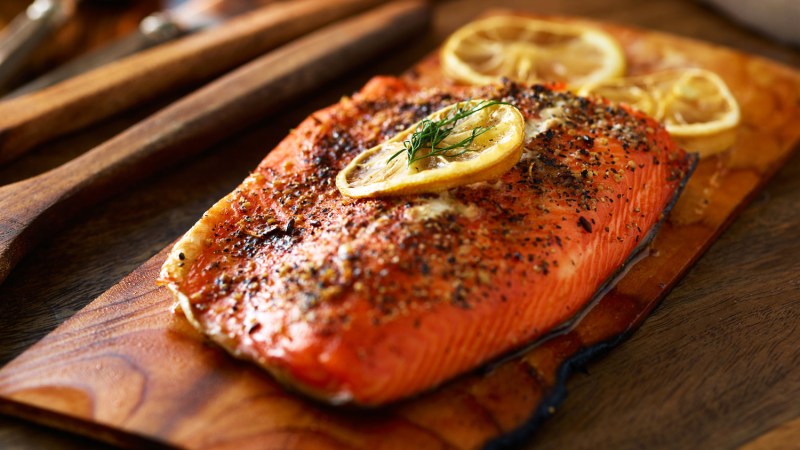
Sorghum and Salt opened earlier this year in Charleston, South Carolina, and has received nothing short of rave reviews. To learn more about a chef’s life, what ingredients every kitchen should have, and how to prepare an out-of-this-world salmon dish, we asked Chef Tres Jackson to give us the lowdown.
Chef Tres Jackson, that’s in interesting name. Do you have a family story that gives some background on who you are and what dishes you create?
We were always around food growing up as my mom always cooked and still does a good bit. In the summers when we visited relatives I would often end up shelling peas and shucking corn with aunts and uncles. That was not always the most fun as a kid but it is certainly relevant to me and my work now – especially as people place more and more of an emphasis on where things come from — and rightly so.
Now that you’re back in South Carolina after running your own restaurant in Tuscaloosa, Alabama — what experiences did you bring with you to Sorghum and Salt in Charleston?
I think all restaurants have their challenges. I also believe they have their own heartbeat and personality, which are ever evolving. Cooking locally and seasonally forces a chef to constantly adapt and find new ways to stay on top of things. As far as Sorghum & Salt goes, we have really tried to embrace that and be interactive with our guests.
A quick look at the current menu shows a healthy balance of offerings, including a plethora of vegetarian choices along with equal numbers of seafood and meat dishes to choose from — not to mention enticing desserts. Is there an ideology behind the creation of your menus?
As far as the menu goes, it will change constantly and evolve from season to season. I think that you have to do that for you and your staff to stay engaged as well as to keep regular customers interested. I believe that restaurants can and should have an ongoing dialogue with their guests and purveyors. I would also say that our menu will always lean towards being very vegetable-driven and that when we do meat and seafood we are very selective about what we buy and where from. We really try to use lesser cuts and incorporate them into dishes as part of a dish in most cases and not the center of the dish.
Now that we’re in salmon season, any pro tips for the layman when it comes to preparing a proper fish dish — any major do’s or don’ts?
Salmon is a great fish, but it can be tricky for people to buy. There is so much farm-raised fish with chemicals that you have to be careful of. Always buy wild-caught salmon or organically-farmed. I do think Salmon is a versatile fish and that you do not have to do much to cook it properly as it’s very forgiving because of the high fat content. If you source correctly, it goes with a lot of different things. I like salmon with yogurt, root vegetables, olive oil and lots of different herbs, seeds and nuts.
Your restaurant Sorghum and Salt is receiving nothing but rave reviews. Literally, there is not a single negative review anywhere. To what do you attribute the positive feedback?
We are truly excited and blessed with the feedback and reception we have received. I think it comes down to just striving to be authentic and being able to tell the story of the ingredients and who brought them to us. Being welcoming and unpretentious is part of the culture here. With a constantly changing menu, we always have new things to speak about and showcase. Lastly, it really comes down to staff being engaged and caring and they have been great.
Just for fun, what is one thing you believe should be in every kitchen?
Good olive oil, yogurt, finishing salt.
In addition to sharing his story and a little about his new restaurant, Chef Tres Jackson wanted to share his recipe for a Salt and Fennel Cured Salmon. It is a simple but impressive technique that can be used at home to impress friends and family during Salmon season:
Fennel and Salt Cured Salmon
*This Recipe also works with Sunburst Trout out of Ashville, NC
Ingredients:
- 1 lb Kosher Salt
- 1 head of Fennel roughly chopped (reserve fronds for garnish)
- 4 – 4 oz Salmon Filets (1-inch thick)
To Cure:
- Grind the fennel with the salt in a food processor until its well incorporated
- Completely submerge the fish in the salt and cure for 30 minutes (*for Sunburst Trout or thinner filets cure for 20 minutes)
- Rinse the filets well to completely wash off all salt
To Prepare:
- Get a cast iron pan super-hot and coat with a couple drops of grapeseed oil.
- Sear the salmon on the skin side until the skin is crisp and does not stick.
- Sear lightly on the other side of the filet and remove from heat and allow to rest for 5 minutes and come up to medium rare.
- Season with finishing salt.


